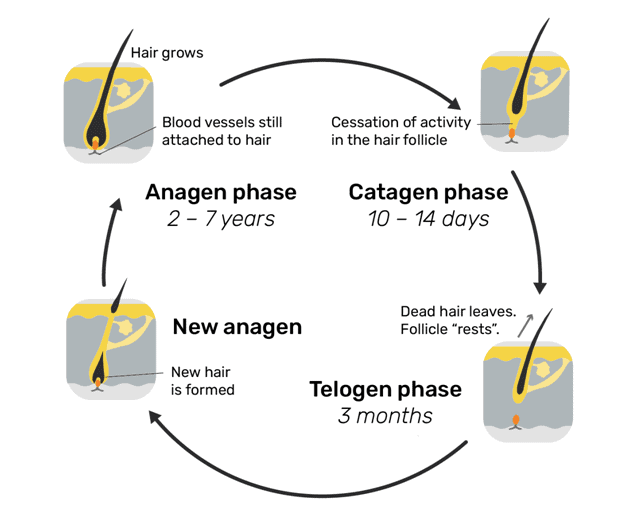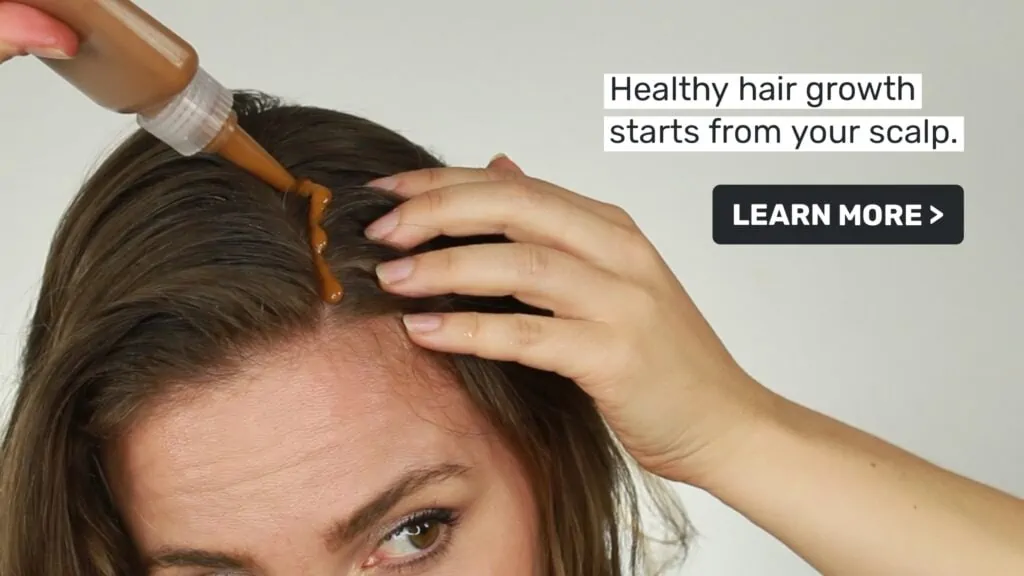The length of your hair depends largely on the length of anagen – or growth – stage, of your hair growth cycle. However, at the cornerstone of these processes lies blood flow in scalp: the transportation system for the oxygen and nutrients to the hair follicle. Different factors can affect the blood supply to your hair follicles, from lifestyle choices, products you use and don’t use, nutrition and genetics.
We look closely at the relationship between blood flow, hair growth and hair loss attempting to answer the question if increasing blood supply to scalp – to the hair root helps hair growth. Numerous studies support the view that better scalp blood flow leads to better hair and reduction of hair loss, we examined this relationship below and summarised the research done in that field over the last few decades including more recent years. Knowing the mechanics and biology of scalp blood flow better equips you in understanding your hair in your hair growth journey helping you reach your goals faster.
Anatomy of hair follicle
Your skin, including that on your scalp consists of three main layers: epidermis (outer layer), dermis (middle layer) and subcutis or hypodermic (subcutaneous fat). The root of your follicles is situated in the lower part of the dermis, at the border of dermis and subcutaneous fat tissue.
The lower third of the hair follicle is enveloped by a rich vascular plexus – a net of blood vessels. It is also entangled in nerves that are linked all the way back to our brains and nervous system. This is what’s responsible for making our hair “stand up” either when it’s cold or when we feel scared.
Underneath that, the subcutaneous fat tissue is incredibly important when it comes to blood flow to hair. It provides a soft cushioning to your blood vessels which removes unnecessary pressure on them. Otherwise the lack of this cushioning may lead to their reduction in size and therefore reduced supply of blood to your follicle. You can think about this as a soft soil for a plant’s root network to develop – it is much easier for the root to develop in softer soil – i.e. with a fatty tissue underneath, than without.

Hair follicles renew and reconsitute themselves though the hair cycle, which also suggests the presence of intrinsic stem cells. Stem cells are detected in the bulge area, the middle, shared part of outer root sheath and not at the bottom of the follicle, as previously believed.
Bulge stem cells has high capacity for proliferation (multiplication) and high potency to regenerate – and not only hair follicles but also sebaceous glands and epidermis. This is one of the reasons why people lose their hair as a result of chemotherapy. Chemotherapy is supposed to kill off the cells which multiply fast – cancer cells – but that also means stem cells in hair follicles that are also highly effective in multiplication get destroyed by chemo, too. The genesis of these stems cells are directly responsible for new hair formation and support of hair follicles.
The gene overview
We looked at the “surface” level of the hair follicle. Now let’s take a look at the genetics of hair growth. Before the dive in – here is a quick refresher of what the hair growth cycle looks like.
Anagen phase – the growth face of your hair, takes 2-7 years on average and it is when the hair strand is firmly attached to the derma papilla – a nipple like extension that is connected to the network of blood vessels and capillaries in your scalp.
Catagen phase – is the phase where hair detaches itself from the derma papilla and this is the point where growth of the hair stops. Catagen phase takes about 10-14 days.
Telogen phase is the “resting” stage of hair and takes approximately 3 months. This is where a hair strand leaves the follicle entirely freeing up the space for the next anagen to begin. Because of this duration, when certain events trigger stress-related hair loss, or telogen effluvium, it can take up to 3 months for the hair to fall out. Effectively your hair detached itself from the blood supply as the stressful events were unfolding and affecting your body, but took 3 months for your hair to leave its old home.

Certain cell growth factors, namely VEGF, FGF-5S, IGF-1 and KGF, induce the proliferation of cells in the hair follicle and surrounding vascular system. In other words, these factors are directly responsible for healthy hair growth. This process also further maintains follicles in the anagen phase.
On the other hand, negative factors, like FGF-5, can prematurely terminate the anagen phase.
Blood vessel grow gene
Vascular endothelial growth factor (VEGF) is a signal protein produced by cells that stimulates the formation of blood vessels: “…people with hair loss may have fewer blood vessels. But no one had actually measured how closely blood vessel growth is correlated with hair growth, or what might cause scalp vessels to grow in the first place.” – researchers concluded when compared two groups of mice, one normal and one genetically programmed to produce an abundance of VEGF.
The VEGF-enhanced mice with an artificially increased amount of blood vessels, grew hair faster and thicker in the first two weeks of life than control mice. Control mice were treated with an antibody that blocks VEGF activity and then shaved, their hair grew back slower and was thinner than their untreated counterparts.

Longer growth stage gene
In addition to blood flow, science had recently found a number of genes that directly affect the length of anagen stage and transition into catagen (shedding stage) of a hair follicle. Namely, FGF-5 – fibroblast growth factor 5 – a molecule whose normal function is to regulate one step in the progression of the follicle through the hair growth cycle.
FGF-5 inhibits hair growth by blocking the activation of dermal papilla cells, turning them from anagen into catagen. However, if FGF-5 is inhibited, anagen stage extends. Such FGF-5 inhibitor was found in an extract of Sanguisorba officinalis’ root, which, interestingly, in some folk medicine also have been found to have impact on blood. The root of the plant’s name itself means “blood” (Latin: sanguine means blood). Blocking FGF5 in the human scalp extends the hair cycle, resulting in less hair fall, faster hair growth rate and increased hair growth.
Catch-22 of ageing: reduced scalp blood flow
When hair follicle doesn’t receive enough blood, it falls into a vicious cycle – known as hair follicle miniaturisation.
This is where the follicle decreases in size and thus – requires less blood supply. But, the less blood supply there is, the less nutrients it brings to the follicle, which further slows down the rate of hair growth and hair thickness. Those nutrients, whether consumed as part of supplementation or balanced nutrition never end up reaching the hair follicle. This “starves” the hair root from much needed fuel even further. This can eventually lead to terminal (thick and visible) hair turning into vellus (transculent) hair.
As we age, hair follicle minituarisation can occur due to a variety of reasons – often a combination of lifestyle factors and general ageing process:
- Many men and some women fall victims to androgenic alopecia, which is hair loss and thinning that relates to the sensitivity to androgens in scalp which causes hair follicle minituarisation process described above.
- Androgens are commonly known as “male sex hormones” – which isn’t the correct way to identify them, since all genders manufacture testosterone which is the most “popular” androgen – just in varied amounts.
- Androgenic alopecia occurs due to receptors to dihydrotestosterone (DHT) molecule – a by-product of testosterone – present in the hair follicle sack. If you thought that only men would be subject to anything to do with testosterone, think again.
- Women suffering from polycystic ovary syndrome (PCOS), or those taking hormone replacement therapy (HRT) can also develop androgenic alopecia. Certain foods can trigger production of androgens in women, specifically those that cause inflammation in body – namely processed foods high in sugar (white bread, pastry, candy, pop soda etc) that spike insulin.
- In women going through menopause the reduction of oestrogen can also lead to hair follicle minituarisation, hair loss and hair thinning.

Blood flow and medication
Some medication and medical treatments can cause reduction in blood flow, examples include targeted therapy and chemotherapy.
Blood flow to scalp is so important in hair cell proliferation and synthesis, that for example, some cancer patients wear a scalp cooling cap during their chemotherapy infusions to prevent the drug affecting hair follicles – to slow down blood flow to scalp. While this slow down the effect, it can’t entirely prevent hair loss associated with some cancer treatments, and any hair growth and blood flow stimulating treatments should be postponed until full course of cancer treatment is completed.
Remedies for increasing blood flow in scalp
Amongst the popular remedies against hair loss are:
- Inversion method to physically instils higher blood flow to scalp
- Scalp massages to stimulate blood flow
- Caffeine, popular stimulant in hair growth serums
- Derma rolling to prompt micro wounding and production of collagen as well as improving blood flow
- Castor oil with its main active ingredient being ricinoleic acid, which activates receptors in hair follicles promoting blood flow and production of keratinocytes
All these aid the proliferation of stem cells to support new hair growth, as well as strengthening existing hair follicles. Hair miniaturisation commonly associated with ageing, have also been repeatedly reported to go into remission after topical stimulants for blood flow have been introduced.
Do you want to learn which natural oil is best to take care of your hair and help with healthy growth? Take our quick Hair Oil Quiz now >
The Hair Fuel and blood flow in scalp
We developed The Hair Fuel formula based on the principles of “scalp blood flow comes 1st, 2nd and 3rd”. The mask works by improving your subcutaneous blood flow which increases the absorption of the nutrients by your hair follicles from the mask itself, as well as your own body. All these support hair follicle function in its hair growing task.
You can trial out by getting our on-going subscripiton or if you want to commit to your hair transformation fully, our signature 6-month subscription is the one for you.
Sources:
Hair growth effect of minoxidil, [1]
FGF5 as a regulator of the hair growth cycle: Evidence from targeted and spontaneous mutations [2]
Waremochi extract has an inhibitory effect on FGF-5 activity and improves hair loss by prolonging the growth period, [3]
Subcutaneous blood flow in early male pattern baldness [4]
Too Much Sugar Turns Off Gene That Controls Effects Of Sex Steroids, [5]
Fibroblast growth factor 5 inhibits hair growth by blocking dermal papilla cell activation, [6]
Who we are:
The Hair Fuel is an all-natural hair growth mask created by Laura Sagen, who lost a third of her hair after a terrible visit to a hairdresser while suffering from a life-long condition of PCOS associated with androgenic hair thinning. She developed the formulation rooted in the science of scalp blood flow, which has become The Hair Fuel growth mask. Since then, her company has helped thousands of people like you to start growing healthy hair.
We work closely with our lab and manufacturers to ensure the highest quality product. But a product alone is never enough – so we hold your hand throughout your own, unique hair growth journey. Our flagship product, The Hair Fuel mask coupled with tailored advice, digital tools, and online support is there to help you grow the best hair you can. It’s a big claim – but we’re unafraid to make it. Check out our starter bundles >>
FAQ
-
1. How can I increase blood flow to my scalp?
Scalp massage, dermarolling, inversion method are all powerful tools to improve blood flow to scalp. The Hair Fuel also increases blood flow to scalp – thus feeding your hair follicles with oxygen and nutrients they need to grow healthy hair!
-
2. Is blood flow to the scalp good?
Yes, blood flow improves the delivery of oxygen and nutrients to your scalp and hair follicles. This ensure your follicles have enough fuel to grow healthy hair.
-
3. Does blood flow stimulate hair growth?
Yes, blood flow is necessary to deliver nutrients from the foods and supplements you consume to your hair follicles – which stimulate and support them in growing healthy hair.
-
4. How can I increase blood flow to my head naturally?
To increase blood flow for hair growth massage your scalp 5-10 minutes a day. Inversion method where for one week a month you massage your scalp with warm oil every day while having your head upside down (e.g. hanging from the side of a bed or couch). Other remedies include dermastamping, usage of peppermint oil and The Hair Fuel.
-
4. How can I increase blood flow to my head naturally?
To increase blood flow for hair growth massage your scalp 5-10 minutes a day. Inversion method where for one week a month you massage your scalp with warm oil every day while having your head upside down (e.g. hanging from the side of a bed or couch). Other remedies include dermastamping, usage of peppermint oil and The Hair Fuel.
-
5. How can I increase blood flow to my scalp naturally?
Massage your scalp 5-10 minutes a day. Inversion method where for one week a month you massage your scalp with warm oil every day while having your head upside down (e.g. hanging from the side of a bed or couch). Other remedies include dermastamping, usage of peppermint oil and The Hair Fuel.
-
6. How can I increase blood flow to my head?
Massage your scalp 5-10 minutes a day. Inversion method where for one week a month you massage your scalp with warm oil every day while having your head upside down (e.g. hanging from the side of a bed or couch). Other remedies include dermastamping, usage of peppermint oil and The Hair Fuel.
-
7. Can blood circulation regrow hair?
Yes, in fact blood flow to scalp is the fundamental thing you need in order to regrow hair. Blood flow is essential in delivering nutrients and oxygen to your hair follicles thus enabling them to regrow hair.
-
8. How can I get more oxygen to my scalp?
Simple scalp massage improves blood flow to the scalp which delivers oxygen with it, as well. In addition, consumption of iron-rich foods like spinach, lentils or taking iron supplements increase the amount of hemoglobin in your blood. Hemoglobin is responsible for carrying oxygen through your blood vessels.
-
9. How can I increase blood flow to my scalp?
Scalp massages, inversion method, dermarolling and The Hair Fuel all increase blood flow to the scalp.
-
10. How can I increase blood flow to my head naturally?
Scalp massages, inversion method, microneedling and The Hair Fuel all increase blood flow to the scalp.
-
11. What helps stimulate the scalp?
Scalp massage, peppermint oil, rosemary oil, camphor, The Hair Fuel and scalp scrubs: especially those containing natural microgranules made from apricot kernels or coffee grounds.
-
12. Can blood circulation regrow hair?
Yes, in fact one of the most widely spread hair loss treatment, minoxidil (commercial name: Rogaine), has been discovered as a result of medical trials for a blood pressure drug. Blood vessel dilation helps delivery of nutrients and oxygen to your hair follicles that help them grow. There are factors to take into account when regrowing your hair – your lifestyle and habits.
